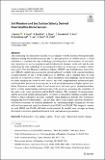| dc.contributor.author | Boutin, J. | |
| dc.contributor.author | Yueh, S. | |
| dc.contributor.author | Bindlish, R. | |
| dc.contributor.author | Chan, S. | |
| dc.contributor.author | Entekhabi, D. | |
| dc.contributor.author | Kerr, Y. | |
| dc.contributor.author | Kolodziejczyk, N. | |
| dc.contributor.author | Lee, T. | |
| dc.contributor.author | Reul, N. | |
| dc.contributor.author | Zribi, M. | |
| dc.date.accessioned | 2023-10-04T18:05:03Z | |
| dc.date.available | 2023-10-04T18:05:03Z | |
| dc.date.issued | 2023-08-28 | |
| dc.identifier.uri | https://hdl.handle.net/1721.1/152373 | |
| dc.description.abstract | Abstract
The monitoring of soil moisture and sea surface salinity over the Earth has been profoundly enhanced during the last thirteen years due to a new generation of satellite sensors. L-band radiometry is currently the only technology providing direct measurements of soil moisture, insensitive to surface roughness and distribution of elements in the soil, and the only technology the only technology for measuring that allows us to measure sea surface salinity from space. The Soil Moisture and Ocean Salinity (SMOS) and Soil Moisture Active Passive (SMAP) satellite missions resolve global and local variability with a spatial resolution of approximately 43 km, a swath width close to 1000 km, and a sampling time, for each mission, of at least twice every 3 days. These resolutions and samplings can be increased by either merging data from the two sensors, and with complementary information gathered from other passive or active sensors, or with in situ information at higher spatial resolution. Numerous scientific studies based on the use of this new type of measurement have led to a better understanding and constraint of the processes governing the variability of the water cycle, ocean circulation and the Earth's climate. The continuity of measurements, and the increased spatial and radiometric resolution is critical for fulfilling scientific needs. Future L-band radiometry missions currently being planned in Europe (the Copernicus Imaging Microwave Radiometer), and in China (the Ocean Salinity mission) should provide better constraints on auxiliary parameters by combining multiple frequencies, but they will not have improved spatial resolution beyond SMOS and SMAP. The temporal continuity with SMOS and SMAP will likely not be ensured. In parallel, new concepts are being developed to increase spatial resolution of both land and ocean parameters. | en_US |
| dc.publisher | Springer Netherlands | en_US |
| dc.relation.isversionof | https://doi.org/10.1007/s10712-023-09798-5 | en_US |
| dc.rights | Creative Commons Attribution | en_US |
| dc.rights.uri | https://creativecommons.org/licenses/by/4.0/ | en_US |
| dc.source | Springer Netherlands | en_US |
| dc.title | Soil Moisture and Sea Surface Salinity Derived from Satellite-Borne Sensors | en_US |
| dc.type | Article | en_US |
| dc.identifier.citation | Boutin, J., Yueh, S., Bindlish, R., Chan, S., Entekhabi, D. et al. 2023. "Soil Moisture and Sea Surface Salinity Derived from Satellite-Borne Sensors." | |
| dc.contributor.department | Massachusetts Institute of Technology. Department of Civil and Environmental Engineering | |
| dc.contributor.department | Massachusetts Institute of Technology. Department of Earth, Atmospheric, and Planetary Sciences | |
| dc.identifier.mitlicense | PUBLISHER_CC | |
| dc.eprint.version | Final published version | en_US |
| dc.type.uri | http://purl.org/eprint/type/JournalArticle | en_US |
| eprint.status | http://purl.org/eprint/status/PeerReviewed | en_US |
| dc.date.updated | 2023-10-01T03:21:36Z | |
| dc.language.rfc3066 | en | |
| dc.rights.holder | The Author(s) | |
| dspace.embargo.terms | N | |
| dspace.date.submission | 2023-10-01T03:21:36Z | |
| mit.license | PUBLISHER_CC | |
| mit.metadata.status | Authority Work and Publication Information Needed | en_US |
